Study on Deformation Characteristics of Low-Highway Subgrade under Traffic Load
Abstract
:1. Introduction
2. Dynamic Triaxial Test of Subgrade Soil under Traffic Load
2.1. Test Equipment and Materials
2.2. Testing Scheme
2.3. Testing Procedure
- (1)
- The on-site soil samples were put into the oven to dry for 24 h. Then, the dried soil samples were crushed into powder by the pulverizer and passed through a 2 mm screen.
- (2)
- The soil sample with an optimum moisture content of 17.01% was prepared by adding distilled water into the screened soil sample. After mixing evenly, the soil sample was put into a plastic bag and sealed for 24 h to make the water thoroughly and evenly mixed with the soil.
- (3)
- Before making the triaxial specimen, the moisture content of the soil sample was measured again to ensure that the error between the measured value and the optimal moisture content was not more than 1%. First, a layer of Vaseline was applied on the inner wall of the sample cylinder (50 mm × 100 mm), and then the prepared soil sample was smashed into the compacting instrument in five layers.
- (4)
- The prepared triaxial specimens were put into a vacuum saturator for vacuum saturation and soaked in water for three days.
- (5)
- The gas in the water pipe of the triaxial test device was discharged by the needle tube, and the sample was installed on the base of the triaxial tester.
- (6)
- The saturation of triaxial specimens was tested. The ratio of pore-pressure increment to confining-pressure increment, after confining pressure, was used as the evaluation index of saturation. If the saturation was above 0.95, the triaxial test would be started directly. If the saturation was less than 0.95, back pressure would be applied at the top of the sample until the saturation reached 0.95.
- (7)
- The specimens were consolidated. In this test, isobaric consolidation () was adopted to apply equal lateral and axial pressures to the specimens. The standard completed in the consolidation stage was wrong with the code for the soil test. The reference source was not found. For reference, the change of consolidation displacement within 1 h is not more than 0.1 cm3.
- (8)
- After the sample reached the consolidation standard, the dynamic load was applied according to the test-design condition, and soil deformation, pore pressure, and other parameters are monitored.
3. Test Results
3.1. Criteria for End of Cyclic Loading
3.2. Time-History Evolution Rule of Subgrade-Soil Dynamic Response
3.2.1. Evolution Rule of Cumulative Strain
3.2.2. Evolution Rule of Pore-Pressure Ratio
3.2.3. Hysteresis Curve
3.3. Spatial Distribution of Dynamic Response of Traffic Load
3.3.1. Spatial Distribution of Cumulative Strain
3.3.2. Spatial Distribution of Pore-Pressure Ratio
3.4. Influence of Traffic-Load Amplitude
3.4.1. Influence Rule of Traffic-Load Amplitude on Strain
3.4.2. Influence Rule of Traffic-Load Amplitude on Pore-Water-Pressure Ratio
3.5. Attenuation Rule of Dynamic Modulus
4. Numerical Calculation and Analysis of Subgrade Deformation
4.1. Validation of Numerical-Calculation Model
4.2. Numerical-Calculation Model
4.3. Subgrade Horizontal Displacement
4.4. Subgrade Vertical Displacement
4.5. Impact of Traffic Load
5. Conclusions
- (1)
- The cumulative strain and pore-water pressure of subgrade soil show a nonlinear growth trend under the action of traffic load. With the increase in loading times, the cumulative strain and pore pressure can be roughly divided into three stages: rapid growth, slow growth, and equilibrium.
- (2)
- The influence of traffic load on the cumulative strain and pore-water pressure of subgrade soil decreases rapidly with the increase in depth. The cumulative strain and pore-water-pressure ratio at a depth of 2.5 m is only one-seventh that of 0.5 m subgrade soil.
- (3)
- The amplitude of traffic load significantly influences the strain and pore pressure of subgrade soil, especially for shallow subgrade. We should pay more attention to the shallow subgrade of the expressway with a large axle load.
- (4)
- As the distance from the subgrade surface increases, the maximum deformation appears at the edge of the subgrade.
Author Contributions
Funding
Institutional Review Board Statement
Informed Consent Statement
Data Availability Statement
Conflicts of Interest
References
- Lekarp, F.; Dawson, A. Modelling permanent deformation behaviour of unbound granular materials. Constr. Build. Mater. 1998, 12, 9–18. [Google Scholar] [CrossRef]
- Werkmeister, S.; Dawson, A.R.; Wellner, F. Permanent Deformation Behavior of Granular Materials and the Shakedown Concept. Transp. Res. Rec. 2001, 1757, 75–81. [Google Scholar] [CrossRef] [Green Version]
- Pérez, I.P.; Romana, M.; Romana, L.M. Permanent deformation models for a granular material used in road pavements. Constr. Build. Mater. 2006, 20, 790–800. [Google Scholar] [CrossRef] [Green Version]
- Nagula, S.S.; Robinson, R.G.; Krishnan, J.M. Mechanical Characterization of Pavement Granular Materials Using Hardening Soil Model. Int. J. Geomech. 2018, 18, 4018157. [Google Scholar] [CrossRef]
- Jing, P.; Nowamooz, H.; Chazallon, C. Permanent deformation behaviour of a granular material used in low-traffic pavements. Road Mater. Pavement Des. 2018, 19, 289–314. [Google Scholar] [CrossRef]
- Cai, Y.; Zhao, L.; Cao, Z.; Gu, C. Experimental study on dynamic characteristics of unbound granular materials under cyclic loading with different frequencies. Chin. J. Rock Mech. Eng. 2017, 36, 1238–1246. [Google Scholar]
- Inam, A.; Ishikawa, T.; Miura, S. Effect of principal stress axis rotation on cyclic plastic deformation characteristics of unsaturated base course material. Soils Found. 2012, 52, 465–480. [Google Scholar] [CrossRef] [Green Version]
- Azam, A.M.; Cameron, D.A.; Rahman, M.M. Permanent Strain of Unsaturated Unbound Granular Materials from Construction and Demolition Waste. J. Mater. Civ. Eng. 2015, 27, 4014125. [Google Scholar] [CrossRef]
- Rahman, M.S.; Erlingsson, S. Moisture influence on the resilient deformation behaviour of unbound granular materials. Int. J. Pavement Eng. 2016, 17, 763–775. [Google Scholar] [CrossRef]
- Lv, X.; Chi, S.; Jia, Y. Experimental study on dynamic deformation behavior of rockfill materials. Chin. J. Geotech. Eng. 2018, 40, 1729–1735. [Google Scholar]
- Wang, K.; Chang, Y.; Chen, N. Residual deformation characteristics of coarse grained soils under cyclic loading. China Civ. Eng. J. 2000, 33, 48–54. [Google Scholar]
- Ling, H.; Fu, H.; Cai, Z.; Mi, Z.; Zhu, F. Experimental study on dynamic deformation behaviors of dam materials. Chin. J. Geotech. Eng. 2009, 31, 1920–1924. [Google Scholar]
- Yang, G.; Liu, H.; Chen, Y.; Shen, Y. Research on size effect of rock-fill materials on dynamic deformation property. J. Hydroelectr. Power 2009, 5, 1003–1243. [Google Scholar]
- Zhu, S.; Zhou, J. Deformation behaviour of coarse grained materials under cyclic loading. Rock Soil Mech. 2010, 5, 1375–1380. [Google Scholar]
- Wang, Z.; Chen, S.; Fu, Z. Dilatancy behaviors and generalized plasticity constitutive model of rockfill materials. Rock Soil Mech. 2015, 7, 1931–1938. [Google Scholar]
- Bailly, P.; Delvare, F.; Via, J.; Hanus, J.L.; Biessy, M.; Picart, D. Dynamic behavior of an aggregate material at simultaneous high pressure and strain rate: SHPB triaxial tests. Int. J. Impact Eng. 2011, 2, 73–84. [Google Scholar] [CrossRef] [Green Version]
- Araei, A.A.; Tabatabaei, S.H.; Razeghi, H. Cyclic and post-cyclic monotonic behavior of crushed conglomerate rockfill material under dry and saturated conditions. Sci. Iran. 2012, 19, 64–76. [Google Scholar] [CrossRef] [Green Version]
- Flora, A.; Lirer, S.; Silvestri, F. Undrained cyclic resistance of undisturbed gravelly soils. Soil Dyn. Earthq. Eng. 2012, 43, 366–379. [Google Scholar] [CrossRef]
- Vos, E.; Couvreur, J.F.; Vermaut, M. Comparison of numerical analysis with field data of a road widening project on peatysoil. In Proc. International Workshop: Advances in Understanding and Modeling the Mechanical Behavior of Peat; Balkema: Rotterdam, The Netherlands, 1994; pp. 67–274. [Google Scholar]
- Xing, H.F.; Li, H.M. Controlling Criterion for Differential Settlement of Widened Expressway. Appl. Mech. Mater. 2012, 238, 818–822. [Google Scholar] [CrossRef]
- Wei, J.; Wang, Z.; Zheng, J.; Zhao, W. The Finite Element Analysis of Highway Unilateral Widened Deformation Characteristics on Soft Soil Ground. J. Comput. Theor. Nanosci. 2012, 6, 337–341. [Google Scholar] [CrossRef]
- Cui, X.Z. Traffic-induced settlement of subgrade of low liquid limit silt in Yellow River delta. China Civ. Eng. J. 2012, 45, 154–162. [Google Scholar]
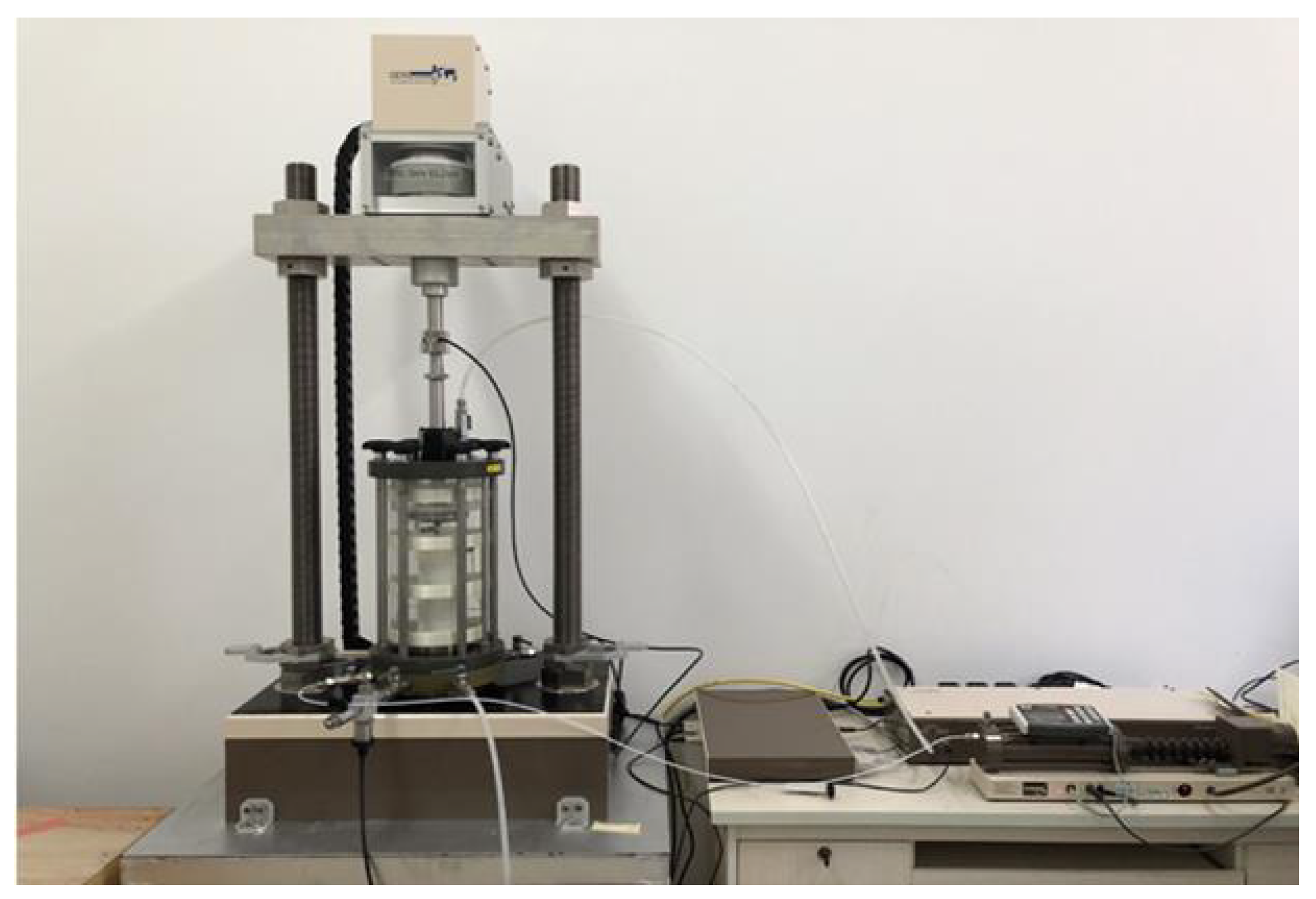

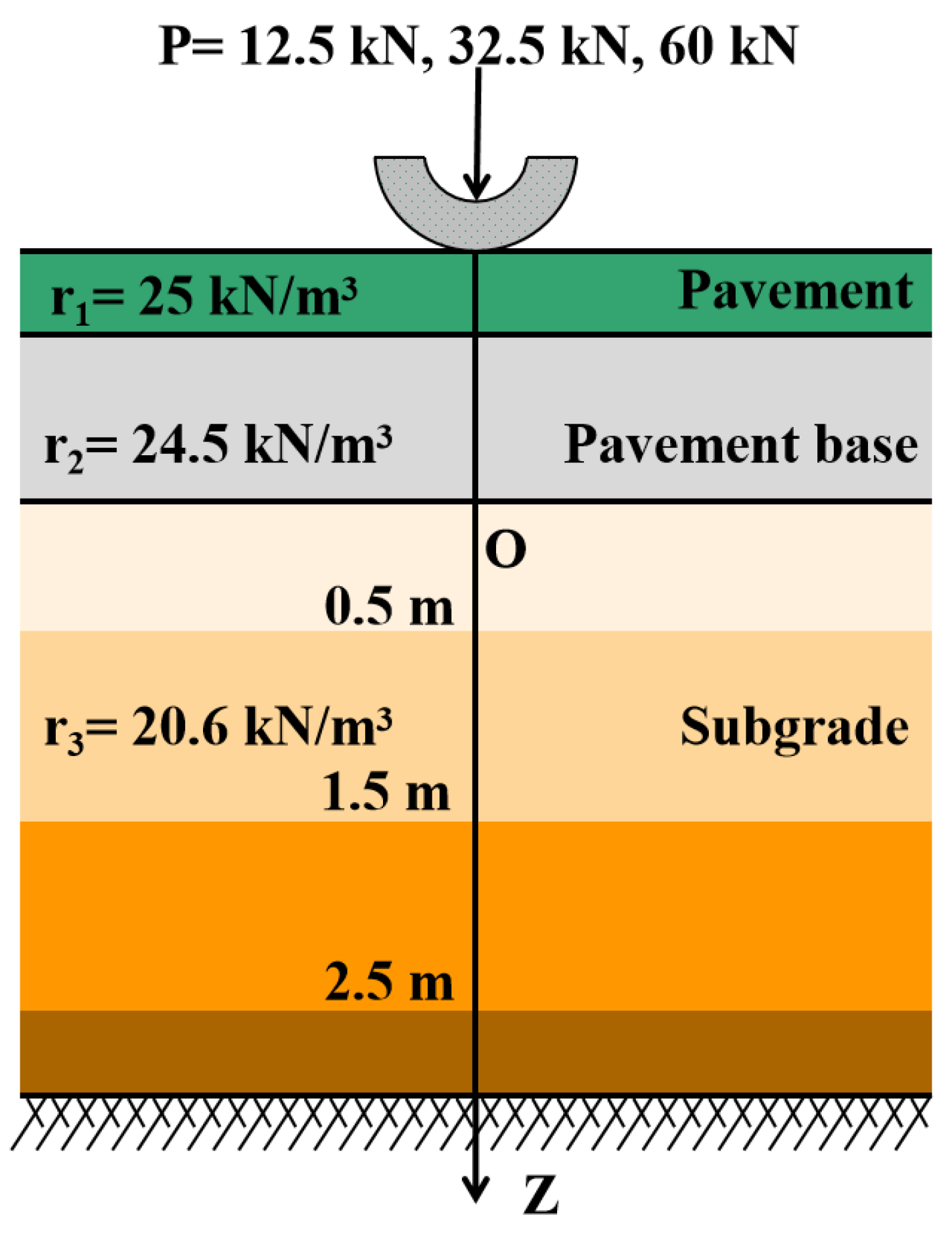
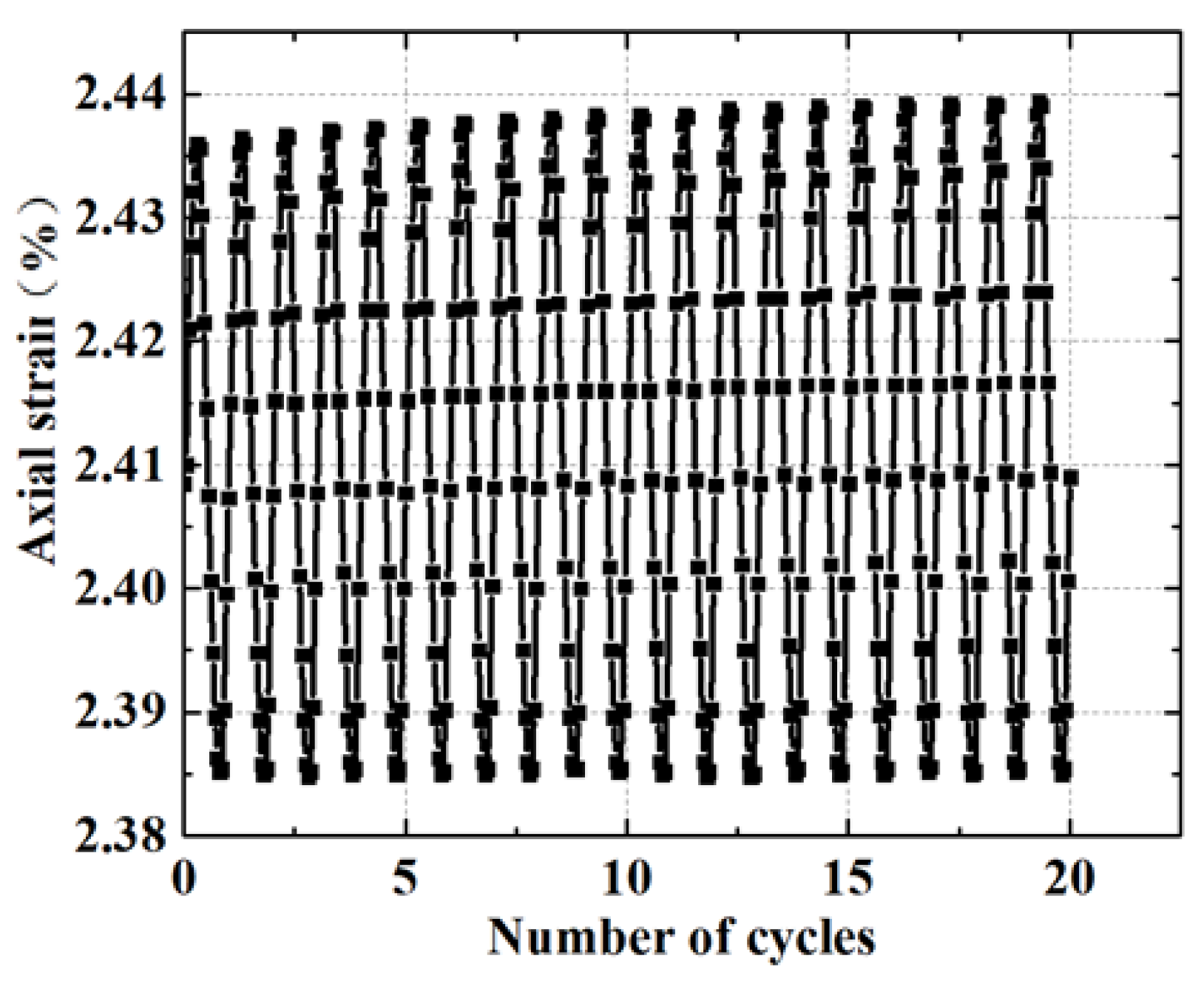
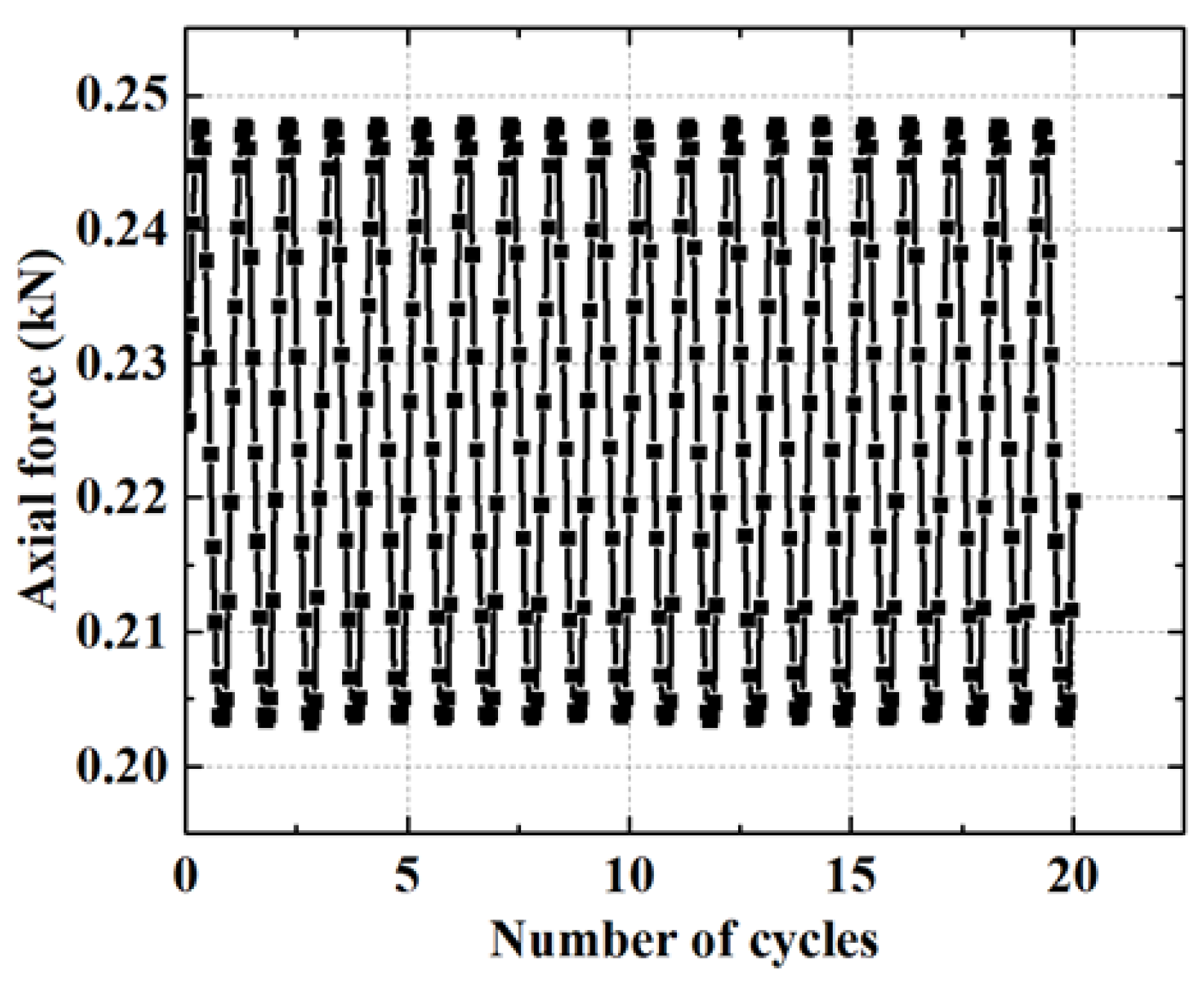
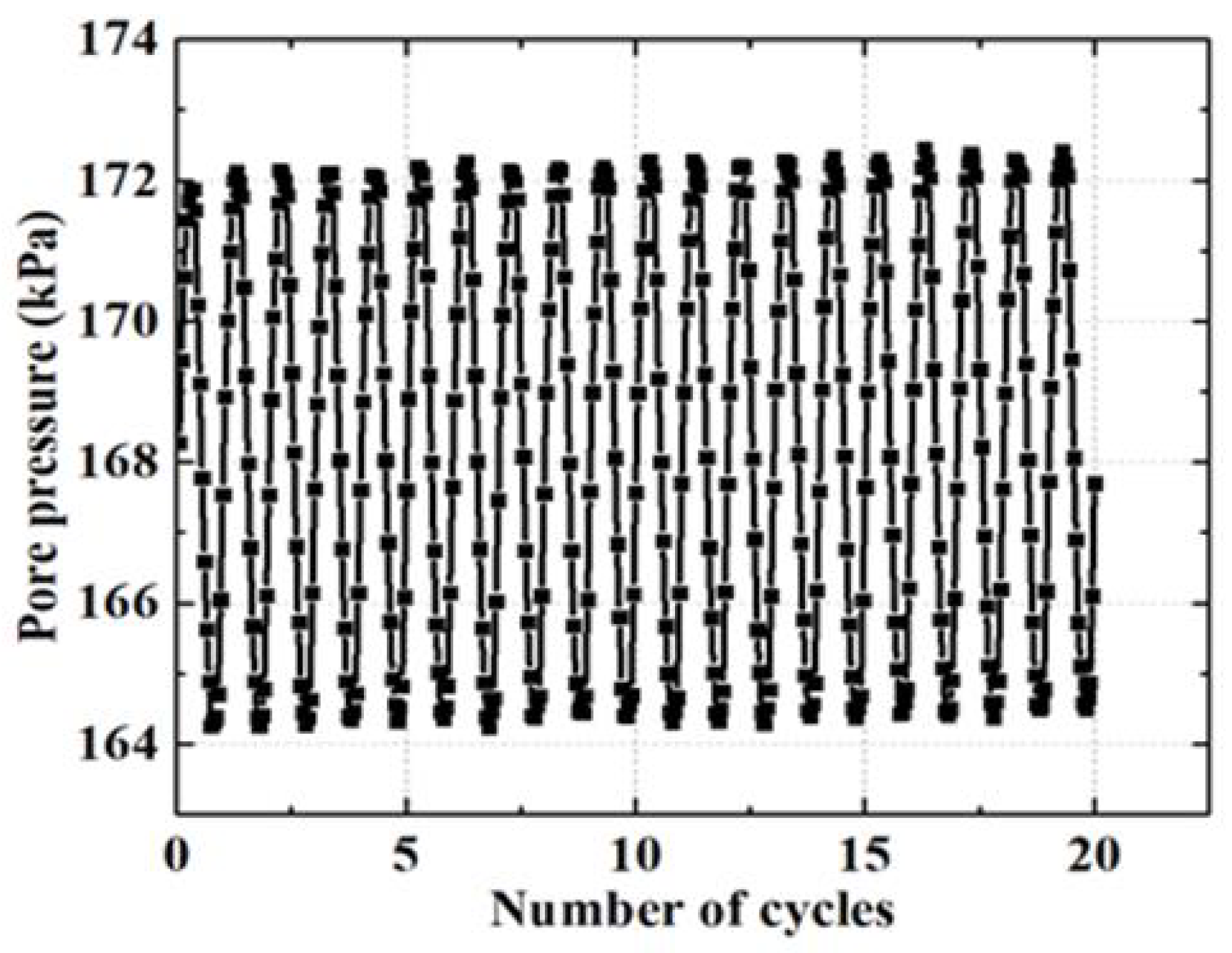
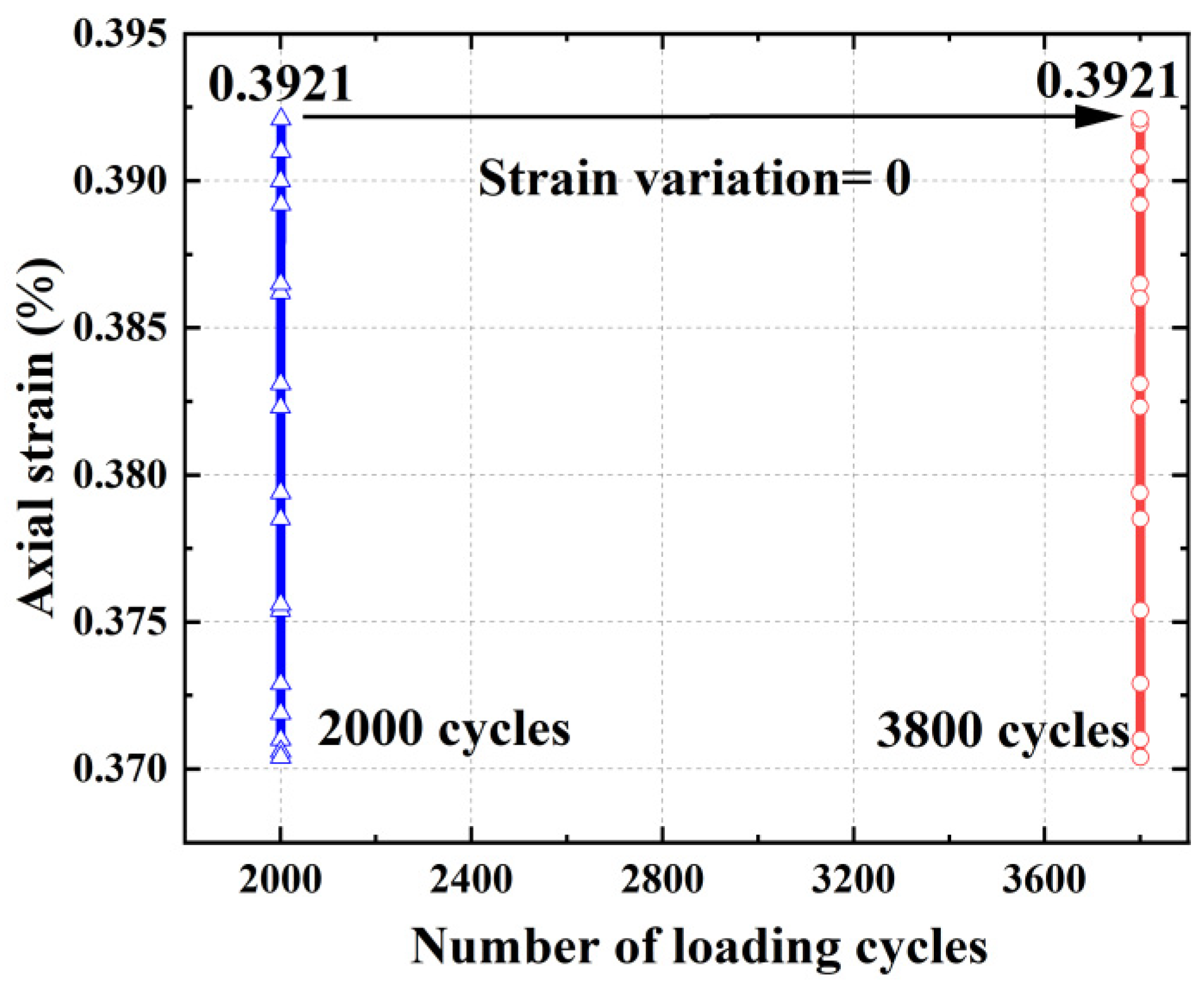

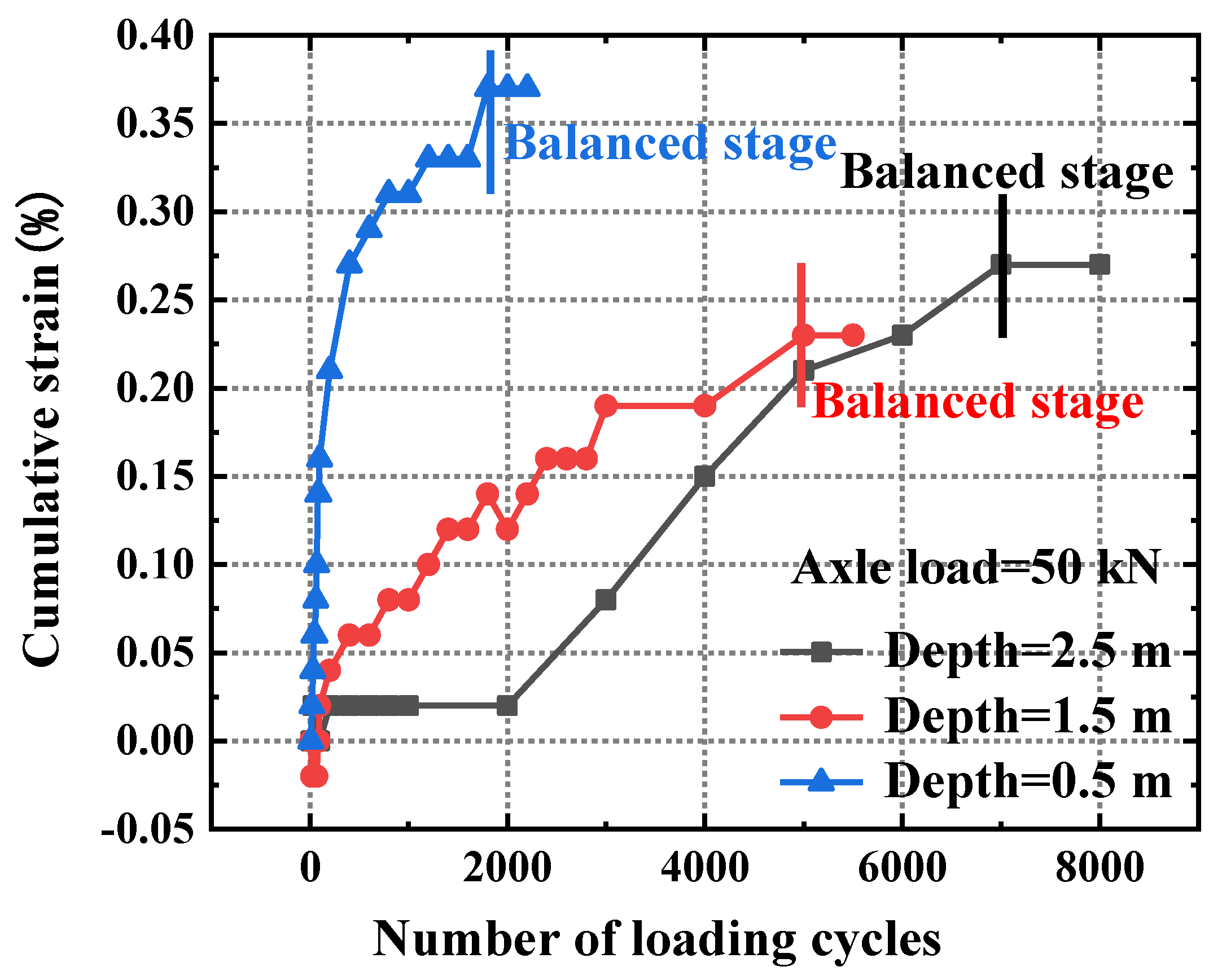

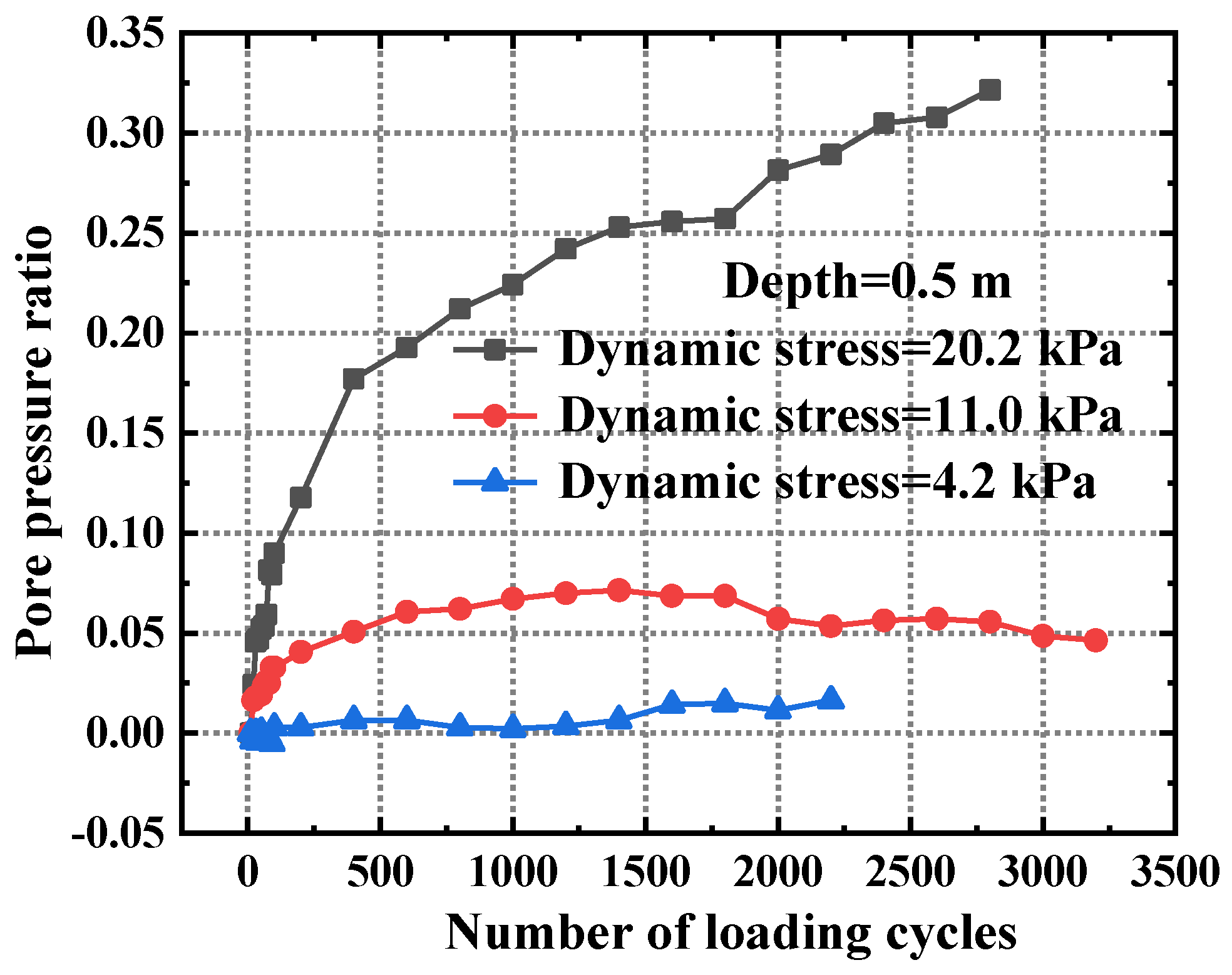
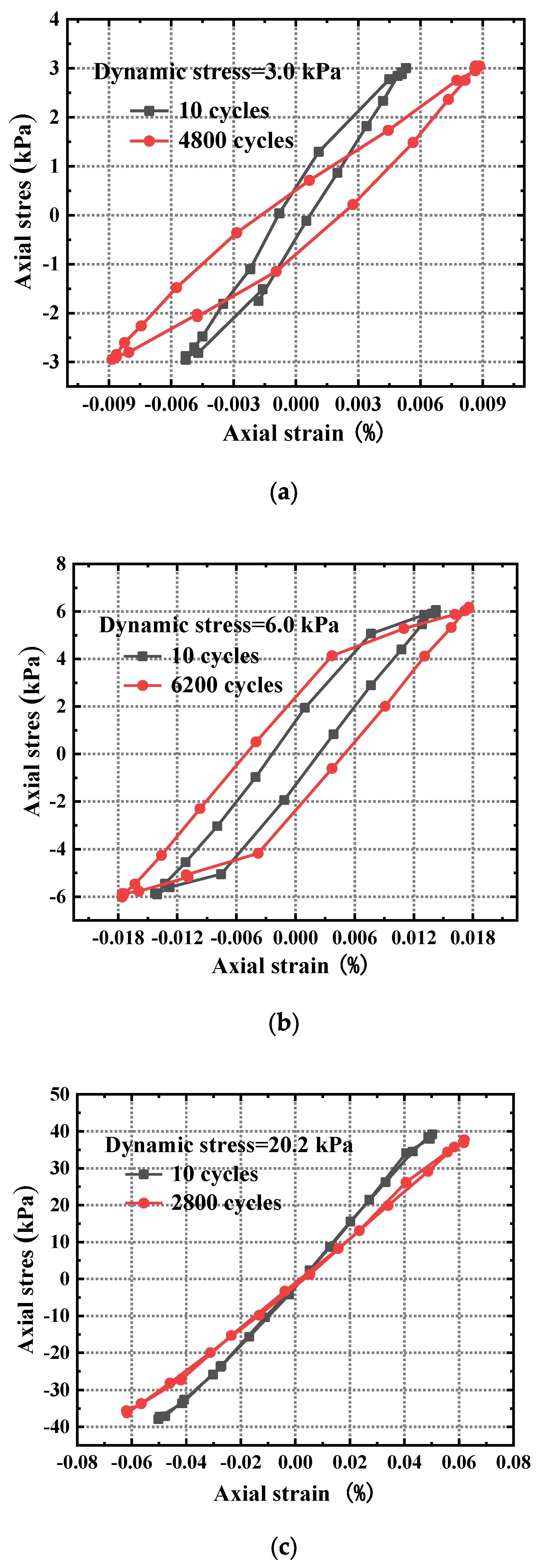
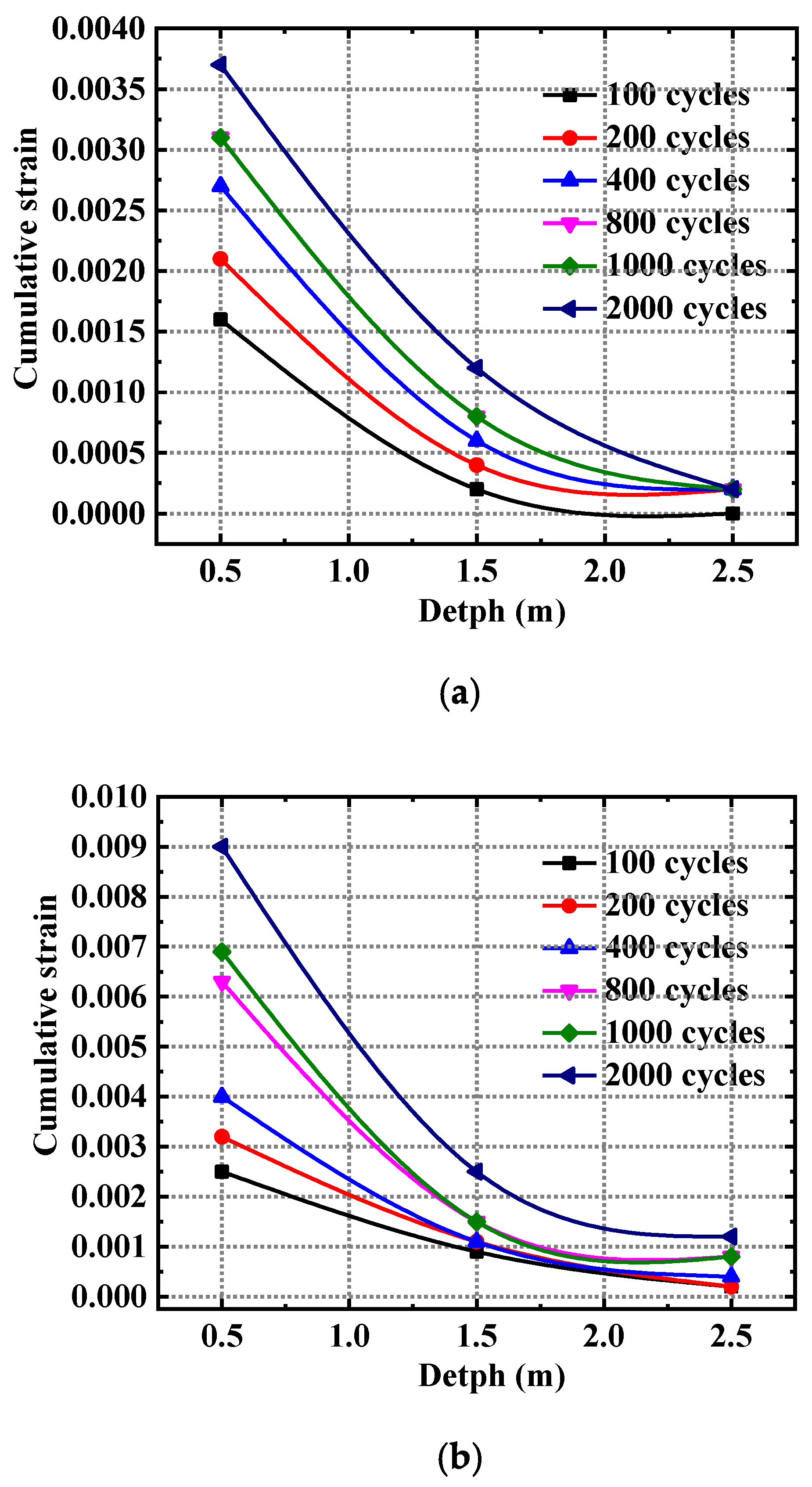
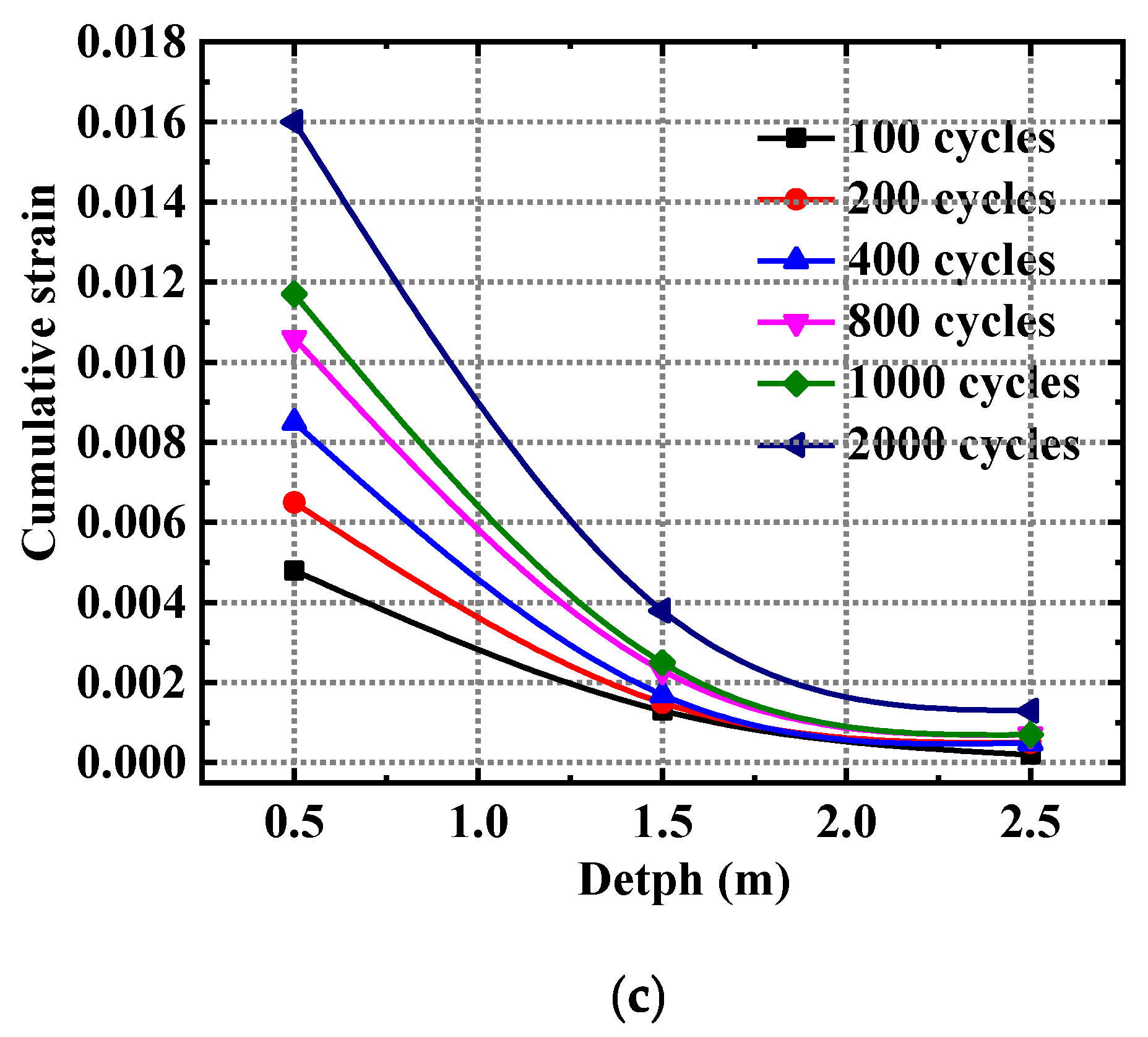
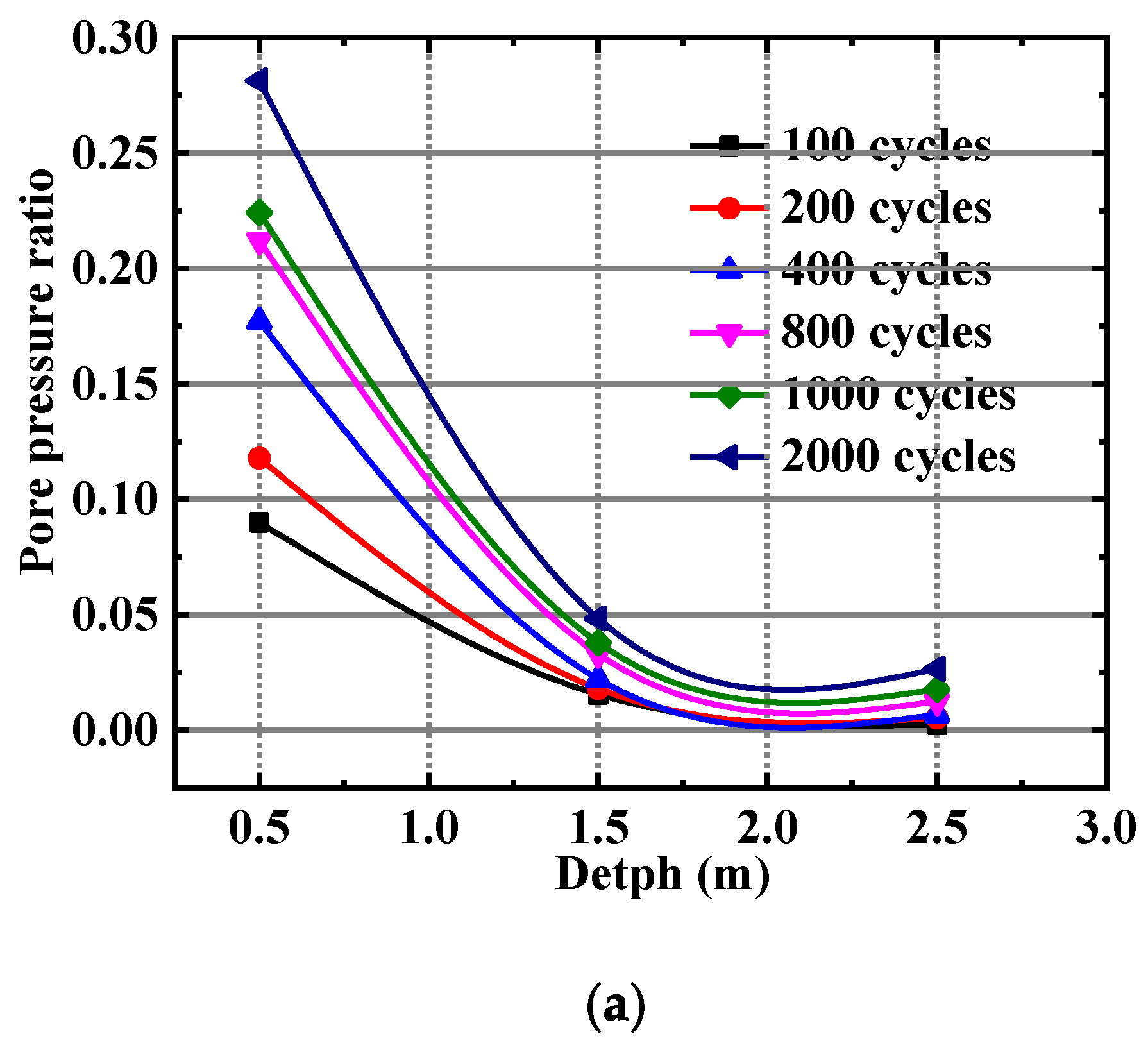
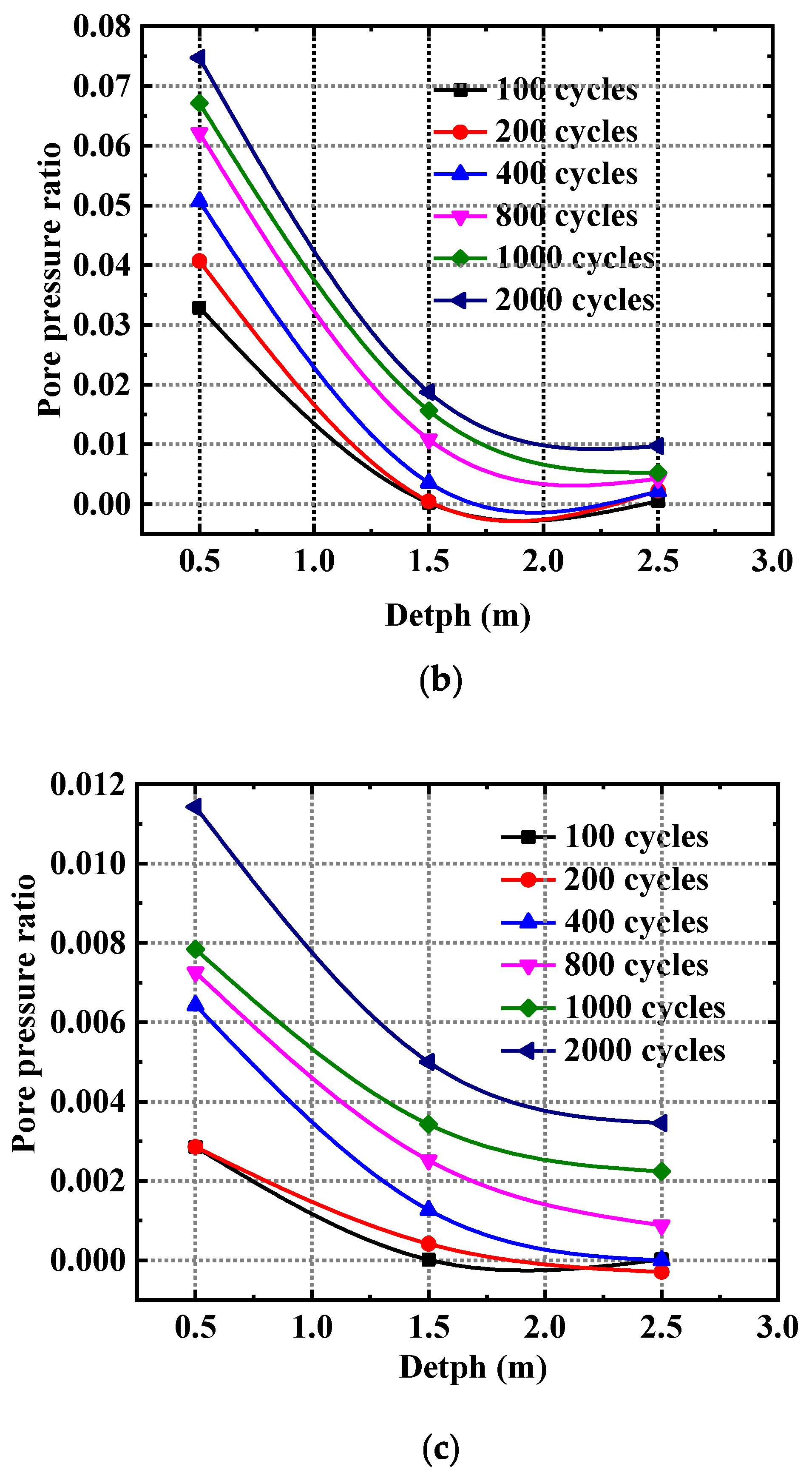


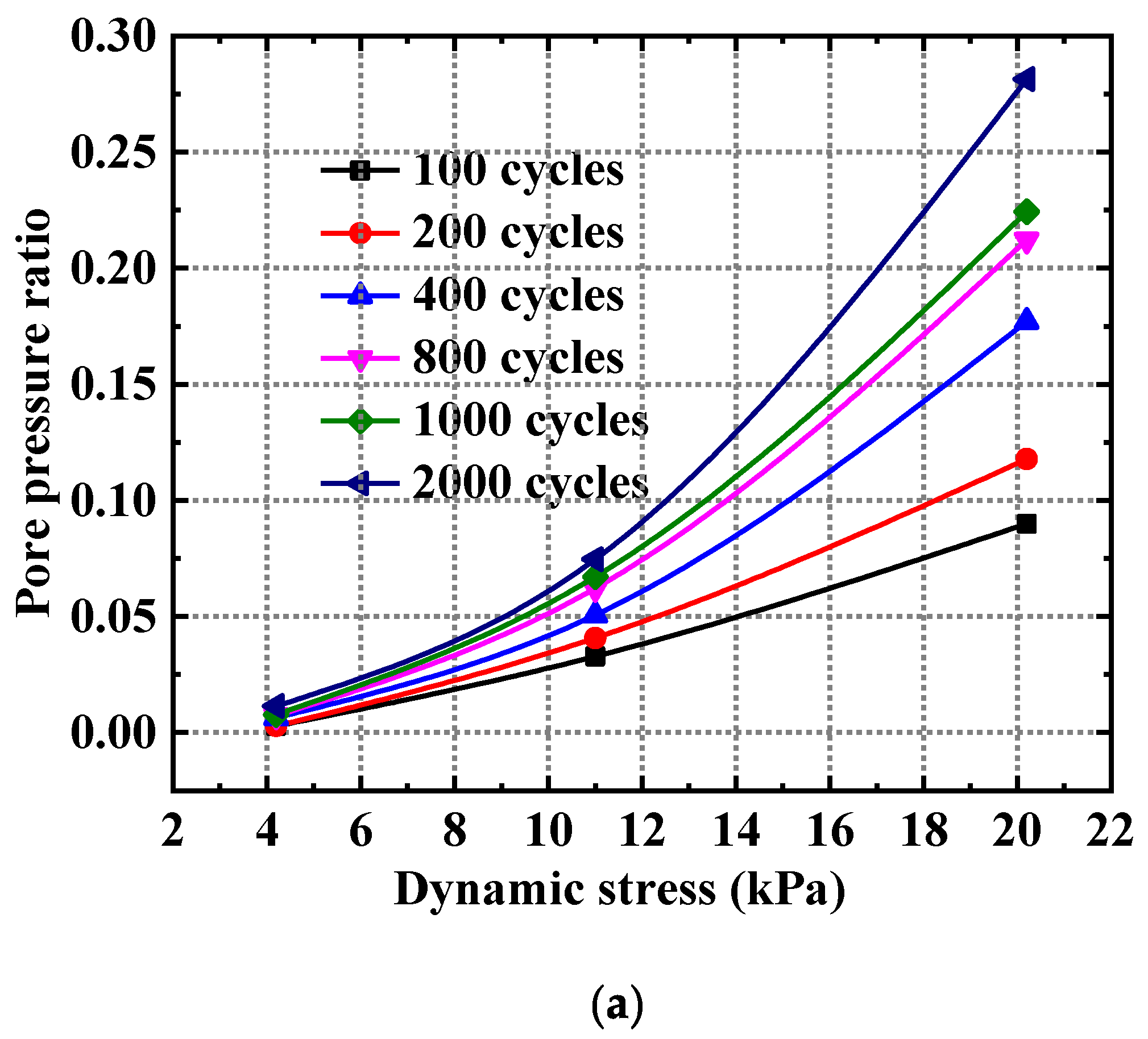
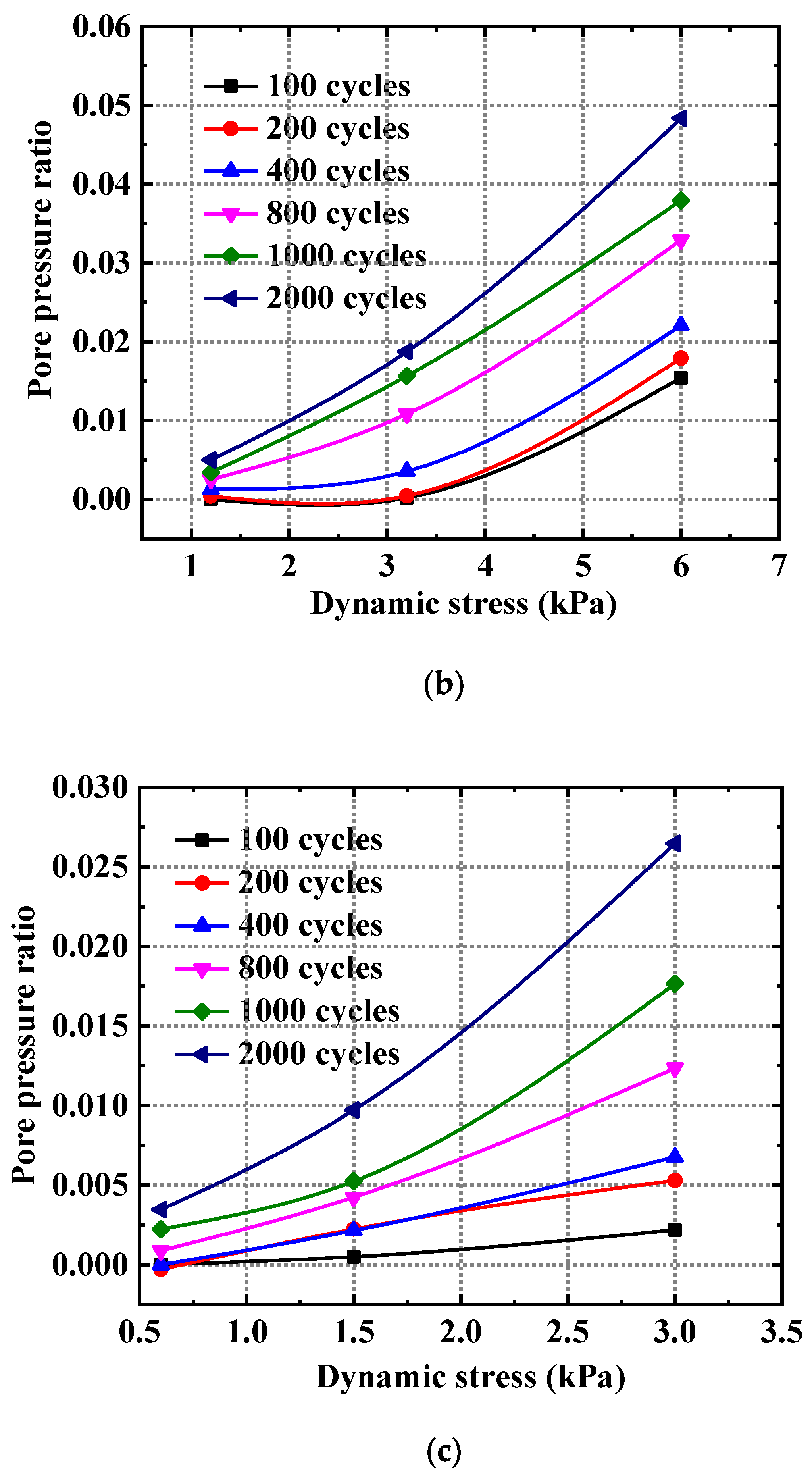
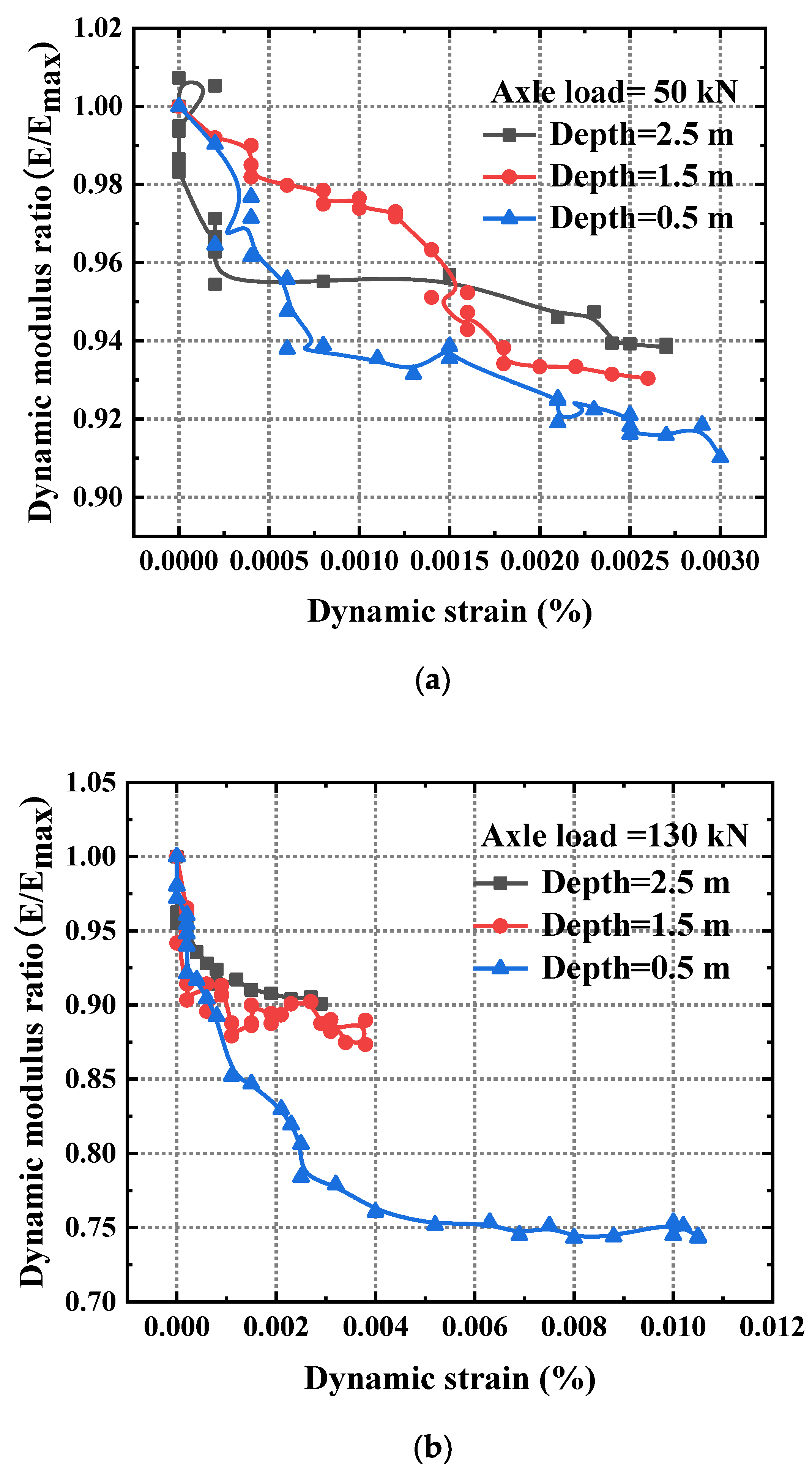
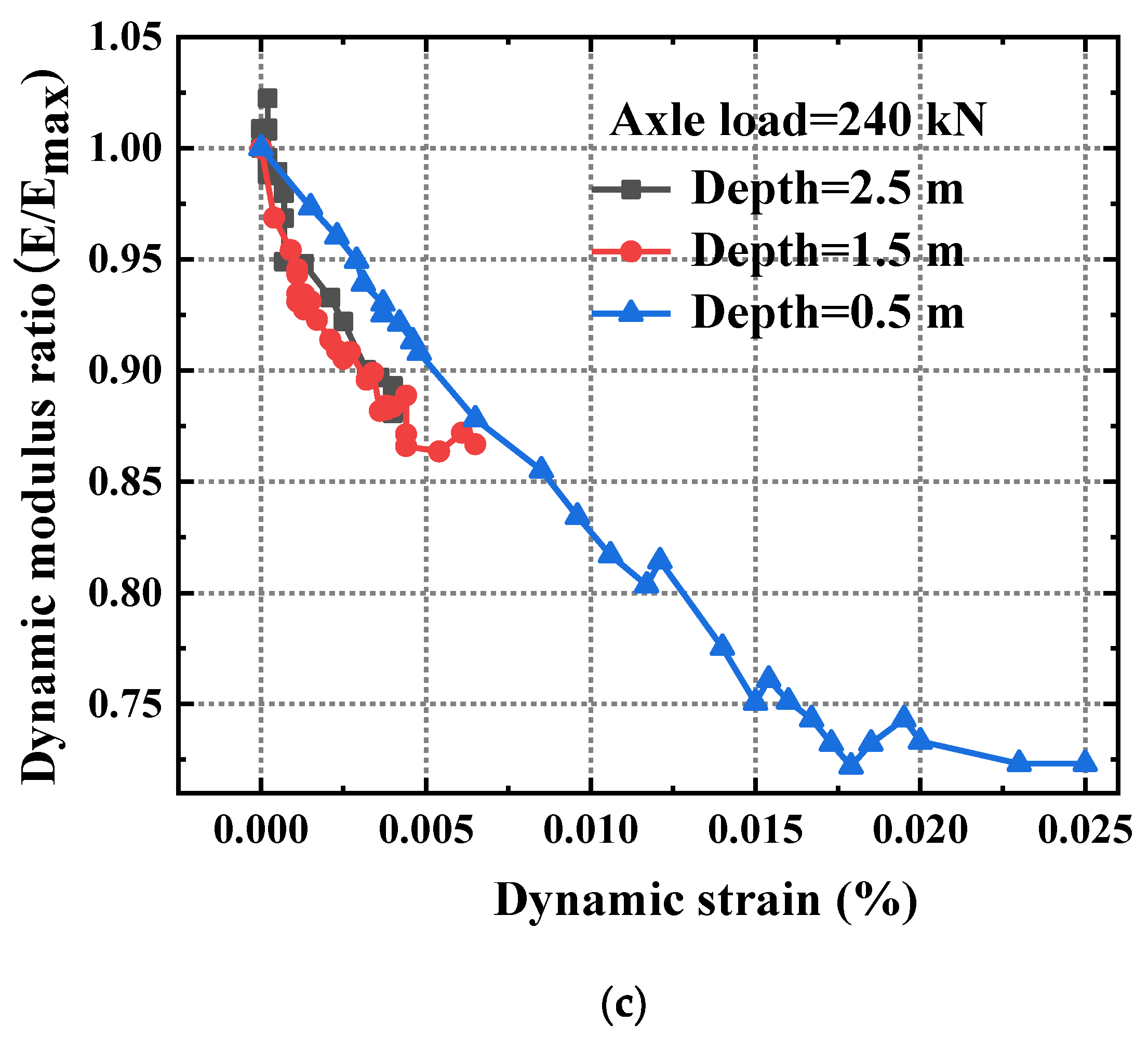

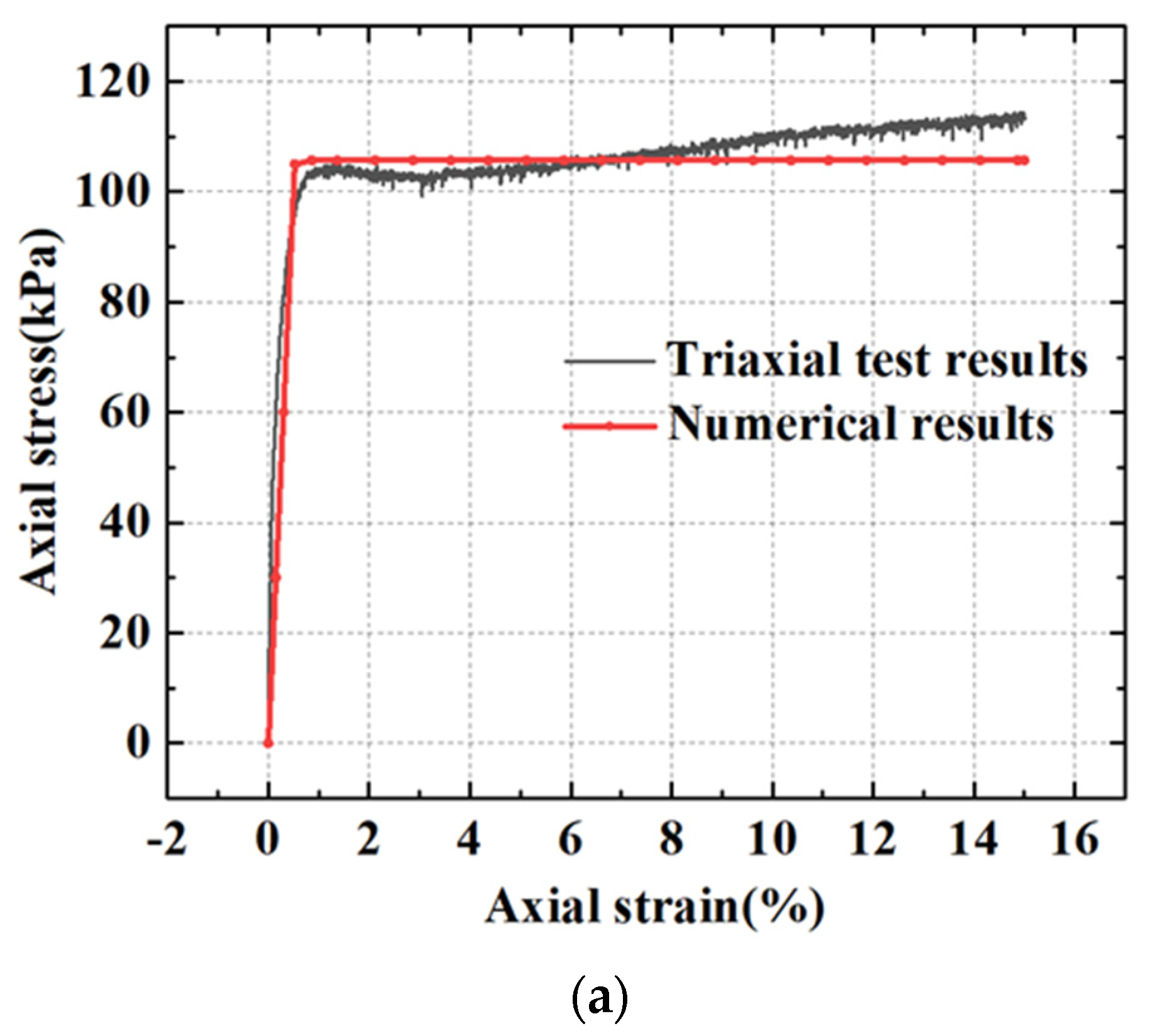


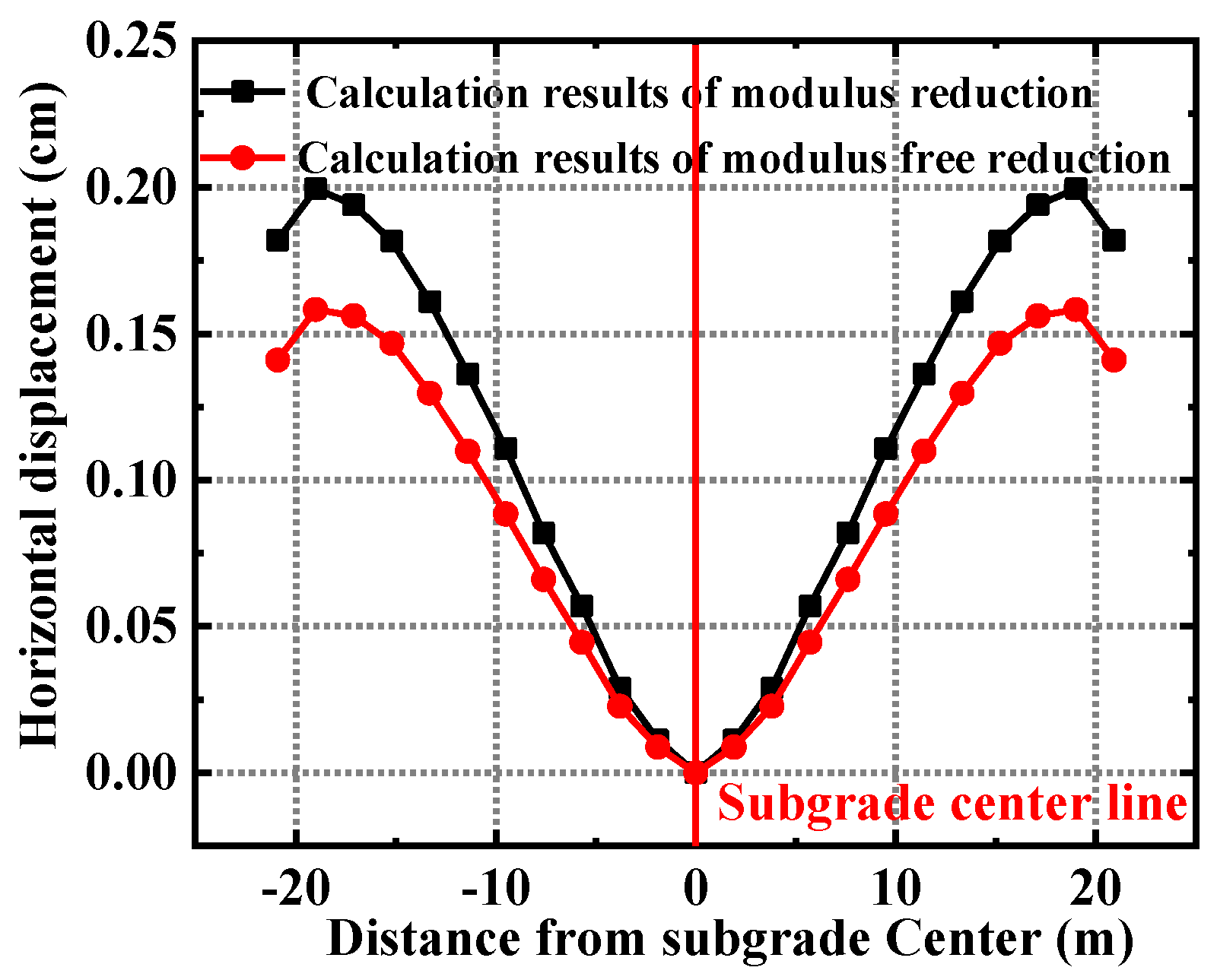

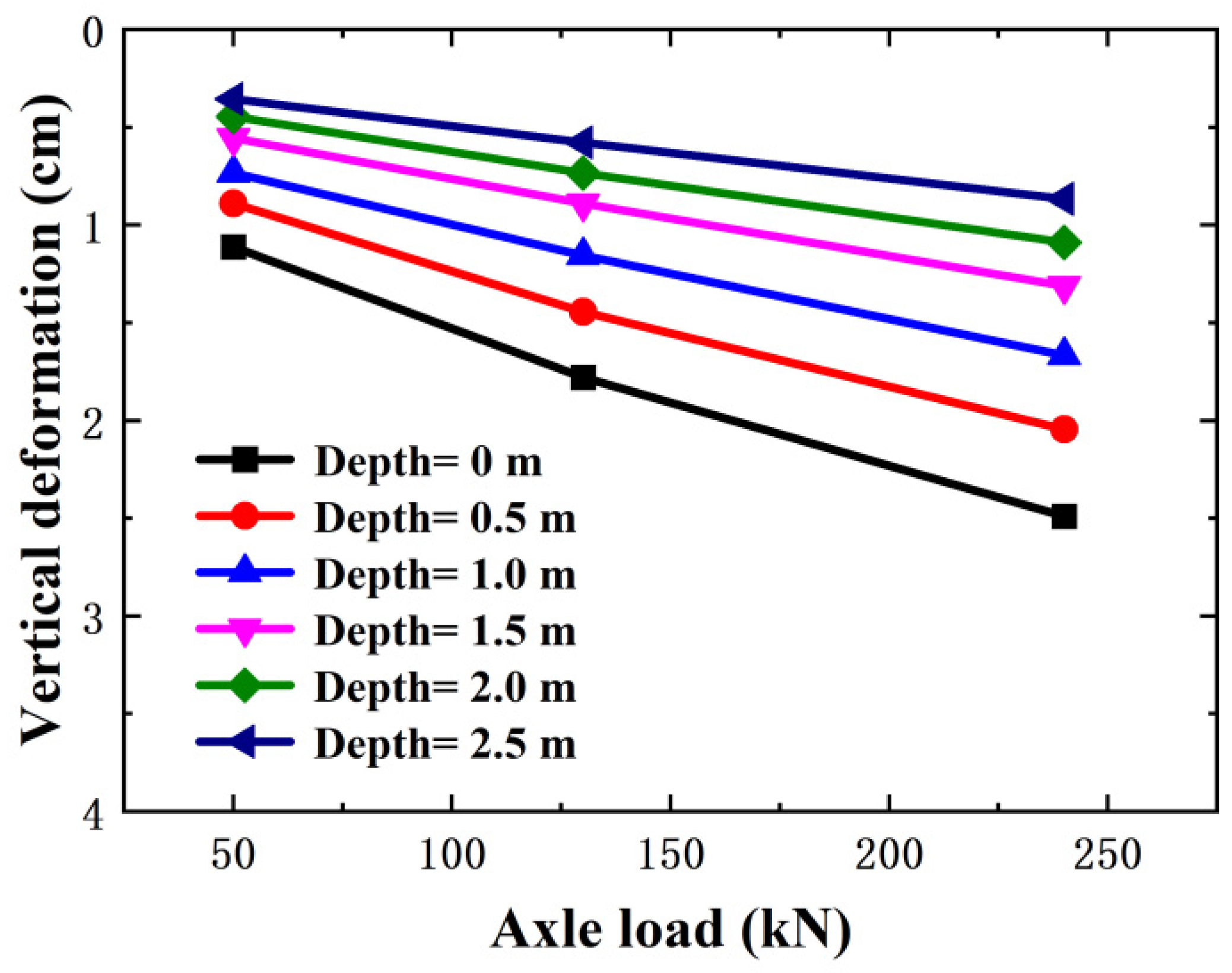
| Maximum Dry Density (g/cm3) | Liquid Limit (%) | Plastic Limit (%) | Plasticity Index | Optimum Water Content (%) | Cohesion (kPa) | Internal Friction Angle (°) |
|---|---|---|---|---|---|---|
| 1.76 | 36.96 | 18.20 | 8.70 | 17.03 | 4.59 | 30.78 |
| Test Number | Borrow Depth (m) | Confining Pressure (kPa) | Wheel-Axle Weight (kN) | Dynamic Stress (kPa) | Frequency (Hz) |
|---|---|---|---|---|---|
| I-1 | - | - | 50 | 4.2 | 1 |
| I-2 | 0.5 | 14 | 130 | 11.0 | |
| I-3 | - | - | 240 | 20.2 | |
| II-1 | - | - | 50 | 1.2 | |
| II-2 | 1.5 | 24 | 130 | 3.2 | |
| II-3 | - | - | 240 | 6.0 | |
| III-1 | - | - | 50 | 0.6 | |
| III-2 | 2.5 | 34 | 130 | 1.5 | |
| III-3 | - | - | 250 | 3.0 | |
| III-1 | 0.5 | 14 | - | - | |
| III-2 | 1.5 | 24 | - | - | |
| III-3 | 2.5 | 34 | - | - |
| Subgrade Depth (m) | Axle Load 50 kN | Axle Load 130 kN | Axle Load 240 kN |
|---|---|---|---|
| 0.5 | 4.2 kPa | 11.0 kPa | 20.2 kPa |
| 1.5 | 1.2 kPa | 3.2 kPa | 6.0 kPa |
| 2.5 | 0.6 kPa | 1.5 kPa | 3.0 kPa |
| Axle Load 50 kN | Axle Load 130 kN | Axle Load 240 kN | |
|---|---|---|---|
| 0.5 m–1.5 m | 0.0202 | 0.1218 | 0.1436 |
| 1.5 m–2.5 m | 0.0087 | 0.0139 | 0.0140 |
| Subgrade Structure | Traffic Load (kN) | Density (kg/m3) | Elastic Modulus (MPa) | Shear Modulus (MPa) | Poisson Ratio | Cohesion (kPa) | Internal Friction Angle (°) |
|---|---|---|---|---|---|---|---|
| Subgrade | 50, 100, 200 | 1760 | 26.1 | 9.7 | 0.36 | 4.585 | 30.78° |
| Foundation | 1840 | 35.0 | 13.5 | 0.30 | 5.0 | 35.0° |
Publisher’s Note: MDPI stays neutral with regard to jurisdictional claims in published maps and institutional affiliations. |
© 2022 by the authors. Licensee MDPI, Basel, Switzerland. This article is an open access article distributed under the terms and conditions of the Creative Commons Attribution (CC BY) license (https://creativecommons.org/licenses/by/4.0/).
Share and Cite
Qi, H.; Zhang, X.; Liu, J.; Zhang, T.; Lv, G.; Cui, L.; Xie, Q. Study on Deformation Characteristics of Low-Highway Subgrade under Traffic Load. Appl. Sci. 2022, 12, 3406. https://doi.org/10.3390/app12073406
Qi H, Zhang X, Liu J, Zhang T, Lv G, Cui L, Xie Q. Study on Deformation Characteristics of Low-Highway Subgrade under Traffic Load. Applied Sciences. 2022; 12(7):3406. https://doi.org/10.3390/app12073406
Chicago/Turabian StyleQi, Hui, Xuesen Zhang, Jian Liu, Tiantao Zhang, Gaohang Lv, Lizhuang Cui, and Quanyi Xie. 2022. "Study on Deformation Characteristics of Low-Highway Subgrade under Traffic Load" Applied Sciences 12, no. 7: 3406. https://doi.org/10.3390/app12073406
APA StyleQi, H., Zhang, X., Liu, J., Zhang, T., Lv, G., Cui, L., & Xie, Q. (2022). Study on Deformation Characteristics of Low-Highway Subgrade under Traffic Load. Applied Sciences, 12(7), 3406. https://doi.org/10.3390/app12073406






